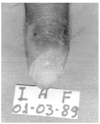Diagnosis and Treatment of Local Radiation Injury
Article information
Abstract
The prognosis and medical handling of individuals exposed to external radiation depend upon whether the whole body has been exposed, or the exposure was localized. It is very important for the prognosis and choice of treatment to know how the absorbed dose has been distributed within the body. The dose distribution depends on the condition of exposure and the circumstances of the accident. Local radiation injury (LRI) is much more frequent than whole body exposure (WBE) and hence described in detail in a variety of literature. LRI caused by high doses of radiation (≥ 8~10 Gy) produces signs and symptoms similar to a thermal burn except for the striking delay in the onset of clinical changes, from several days to a week or longer. The severity of LRI depends not only on the dose and type of radiation, but also on the location and size of the area exposed. In general, the higher the dose received, the more rapid the development of pathological symptoms and the more severe the prognosis. Therefore, diagnosis and prognosis should be based upon various parameters, besides the clinical observation, such as dosimetry, reconstruction of the accident, thermography, scintigraphy, etc.







